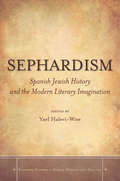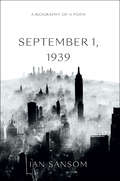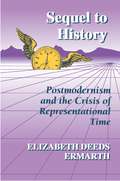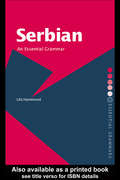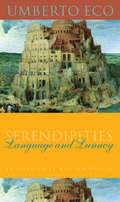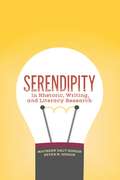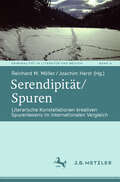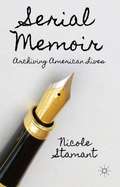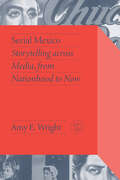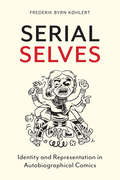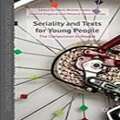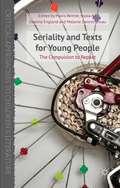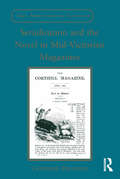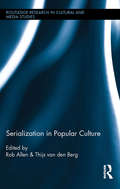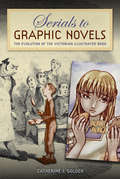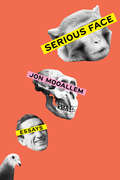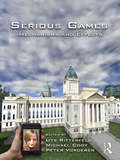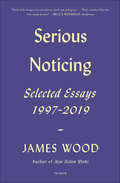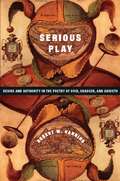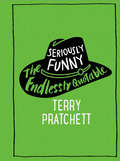- Table View
- List View
Sephardism: Spanish Jewish History and the Modern Literary Imagination
by Yael Halevi-WiseIn this book, Sephardism is defined not as an expression of Sephardic identity but as a politicized literary metaphor. Since the nineteenth century, this metaphor has occurred with extraordinary frequency in works by authors from a variety of ethnicities, religions, and nationalities in Europe, the Americas, North Africa, Israel, and even India. Sephardismasks why Gentile and Jewish writers and cultural figures have chosen to draw upon the medieval Sephardic experience to express their concerns about dissidents and minorities in modern nations? To what extent does their use of Sephardism overlap with other politicized discourses such as orientalism, hispanism, and medievalism, which also emerged from a clash between authoritarian, progressive, and romantic ideologies? This book brings a new approach to Sephardic Studies by situating it at a crossroads between Jewish Studies and Hispanic Studies in ways that enhance our appreciation of how historical fiction and political history have shaped, and were shaped by, historical attitudes toward Jews and their representation.
September 1, 1939: A Biography of a Poem
by Ian SansomOne poet, his poem, New York City, and a world on the verge of change.W. H. Auden, a wunderkind, a victim-beneficiary of a literary cult of personality, became a scapegoat and a poet-expatriate largely excluded from British literary history because he left. And his poem, “September 1, 1939,” was his most famous and celebrated, yet one which he tried to rewrite and disown and which has enjoyed—or been condemned—to a tragic and unexpected afterlife.These are the contributing forces underlying Ian Sansom’s work excavating the man and his most celebrated piece of literature. But Sansom’s book is also about New York City: an island, an emblem of the Future, magnificent, provisional, seamy, and in 1939—about to emerge as the defining twentieth-century cosmopolis, the capital of the world.And so it is also about a world at a point of change—about 1939, and about our own Age of Anxiety, about the aftermath of September 11, when many American newspapers reprinted Auden’s poem in its entirety on their editorial pages.More than a work of literary criticism or literary biography, this is a record of why and how we create and respond to great poetry.
Sequel to History: Postmodernism and the Crisis of Representational Time
by Elizabeth Deeds ErmarthSequel to History offers a comprehensive definition of postmodernism as a reformation of time. Elizabeth Deeds Ermarth uses a diversified theoretical approach drawing on post-structuralism, feminism, new historicism, and twentieth-century science to demonstrate the crisis of our dominant idea of history and its dissolution in the rhythmic time of postmodernism. She enlarges this definition in discussions of several crises of cultural identity: the crisis of the object, the crisis of the subject, and the crisis of the sign. Finally, she explores the relation between language and time in post-modernism, proposing an arresting theory of her own about the rhythmic nature of postmodern temporality. <P><P>Because the postmodern construction of time appears so clearly in narrative writing, each part of this work is punctuated by a "rhythm section" on a postmodern narrative (Robbe-Grillet's Jealousy, Cortezar's Hopscotch, and Nabokov's Ada); these extended readings provide concrete illustrations of Ermarth's theoretical positions. As in her critically acclaimed Realism and Consensus in the English Novel, Ermarth ranges across disciplines from anthropology and the visual arts to philosophy and history. For its interdisciplinary character and its lucid definition of postmodernism, Sequel to History will appeal to all those interested in the humanities.
Sequel: A Handbook for the Critical Analysis of Literature
by Elizabeth Schmuhl Richard C. Guches Meredith Mayberry Jill PeekTextbook for the study and analysis of poetry, fiction, and drama
Serbian: An Essential Grammar (Routledge Essential Grammars)
by Lila HammondSerbian: An Essential Grammar is an up-to-date and practical reference guide to the most important aspects of Serbian as used by contemporary native speakers of the language. Refreshingly jargon free, it presents an accessible description of the language, focusing on the real patterns of use today. A reference source for the learner and user of Serbian irrespective of level, it sets out the complexities of the language in short, readable sections. Features of this Grammar include: * use of Cyrillic and Latin script examples throughout* a cultural section on the language and its dialects* clear and detailed explanations of simple and complex grammatical concepts* detailed contents list and index for easy reference. Well-presented and easy to use, Serbian: An Essential Grammar is ideal either for independent study or for students in schools, colleges, universities and adult education.
Serendipities
by Umberto Eco William WeaverIn a careful unraveling of the fabulous and the false, Eco shows us how serendipities----unanticipated truths----often spring from mistaken ideas. Eco uncovers layers of mistakes that have shaped human history, such as Columbus's assumption that the world was much smaller than it is, leading him to seek out a quick route to the East via the West and thus fortuitously "discovering" America.
Serendipities: Language and Lunacy (Italian Academy Lectures)
by Umberto EcoBest-selling author Umberto Eco's latest work unlocks the riddles of history in an exploration of the "linguistics of the lunatic," stories told by scholars, scientists, poets, fanatics, and ordinary people in order to make sense of the world. Exploring the "Force of the False," Eco uncovers layers of mistakes that have shaped human history, such as Columbus's assumption that the world was much smaller than it is, leading him to seek out a quick route to the East via the West and thus fortuitously "discovering" America. The fictions that grew up around the cults of the Rosicrucians and Knights Templar were the result of a letter from a mysterious "Prester John"—undoubtedly a hoax—that provided fertile ground for a series of delusions and conspiracy theories based on religious, ethnic, and racial prejudices. While some false tales produce new knowledge (like Columbus's discovery of America) and others create nothing but horror and shame (the Rosicrucian story wound up fueling European anti-Semitism) they are all powerfully persuasive.In a careful unraveling of the fabulous and the false, Eco shows us how serendipities—unanticipated truths—often spring from mistaken ideas. From Leibniz's belief that the I Ching illustrated the principles of calculus to Marco Polo's mistaking a rhinoceros for a unicorn, Eco tours the labyrinth of intellectual history, illuminating the ways in which we project the familiar onto the strange.Eco uncovers a rich history of linguistic endeavor—much of it ill-conceived—that sought to "heal the wound of Babel." Through the Middle Ages and the Renaissance, Greek, Hebrew, Chinese, and Egyptian were alternately proclaimed as the first language that God gave to Adam, while—in keeping with the colonial climate of the time—the complex language of the Amerindians in Mexico was viewed as crude and diabolical. In closing, Eco considers the erroneous notion of linguistic perfection and shrewdly observes that the dangers we face lie not in the rules we use to interpret other cultures but in our insistence on making these rules absolute.With the startling combination of erudition and wit, bewildering anecdotes and scholarly rigor that are Eco's hallmarks, Serendipities is sure to entertain and enlighten any reader with a passion for the curious history of languages and ideas.
Serendipity in Rhetoric, Writing, and Literacy Research
by Maureen Daly Goggin and Peter N. GogginIn the course of research, most scholars have known moments of surprise, catastrophe, or good fortune, though they seldom refer to these occurrences in reports or discuss them with students. Serendipity in Rhetoric, Writing, and Literacy Research reveals the different kinds of work scholars, particularly those in rhetoric, writing, and literacy, need to do in order to recognize a serendipitous discovery or a missed opportunity. In published scholarship and research, the path toward discovery seems clean and direct. The dead ends, backtrackings, start-overs, and stumbles that occur throughout the research process are elided, and seems that the researchers started at point A and arrived safely and neatly at point B without incident, as if by magic. The path, however, is never truly clear and straight. Research and writing is messy. Serendipity in Rhetoric, Writing, and Literacy Research features chapters from twenty-three writing scholars who have experienced moments of serendipity in their own work—not by magic or pure chance but through openness and active waiting, which offer an opportunity to prepare the mind. Serendipity in Rhetoric, Writing, and Literacy Research illustrates the reality of doing research: there is no reliable prescription or one-size-fits-all manual, but success can be found with focused dedication and an open mind. Contributors: Ellen Barton, Zachary C. Beare, Lynn Z. Bloom, Jennifer Clary-Lemon, Caren Wakerman Converse, Gale Coskan-Johnson, Kim Donehower, Bill Endres, Shirley E. Faulkner-Springfield, Lynée Lewis Gaillet, Brad Gyori, Judy Holiday, Gesa E. Kirsch, Lori Ostergaard, Doreen Piano, Liz Rohan, Ryan Skinnell, Patricia Wilde, Daniel Wuebben
Serendipität/Spuren: Literarische Konstellationen kreativen Spurenlesens im internationalen Vergleich (Kriminalität in Literatur und Medien #4)
by Reinhard M. Möller Joachim HarstWelche Bedeutung hat Serendipität als Modell ungeplanter, ungesuchter und zufallsgespeister Kreativität für Darstellungen und Praktiken des Spurenlesens? Diese Frage erkundet der vorliegende Band ausgehend von Carlo Ginzburgs Begriff des „Indizienparadigmas“, der Spurenlesen und Zeichendeuten als grundlegende Kulturpraktiken ausweist, einerseits und dem von Horace Walpole 1754 ,erfundenen‘ „serendipity“-Konzept andererseits, das im 20. und 21. Jahrhundert eine stark zunehmende theoretische Konjunktur erfahren hat. Vor diesem Hintergrund untersuchen die Beiträge Schnittpunkte von Spuren und Serendipität in der internationalen (Kriminal-)Literatur sowie in forensischen Ästhetiken und in TV-Serien. Darstellungen des Spurenlesens aus diversen historischen und kulturellen Kontexten werden verglichen, um so die Frage zu bearbeiten, inwiefern Akzentuierungen des Serendipitären alternative Ausprägungen der detektivischen Ratio hervorbringen.
Serial Crime Fiction: Dying for More (Crime Files)
by Jean AndersonSerial Crime Fiction is the first book to focus explicitly on the complexities of crime fiction seriality. Covering definitions and development of the serial form, implications of the setting, and marketing of the series, it studies authors such as Doyle, Sayers, Paretsky, Ellroy, Marklund, Camilleri, Borges, across print, film and television.
Serial Memoir
by Nicole StamantSerial Memoir chronicles the phenomenon of seriality in memoir, a transition in life writing toward repeated acts of self-representation in the later twentieth century. Such a shift demonstrates a new way to understand and represent constantly-shifting subjectivities and their ambivalent relationship to the concept and structure of the archive.
Serial Mexico: Storytelling Across Media, From Nationhood to Now (Critical Mexican Studies)
by Amy E. WrightNo book until now has tied in two centuries of Mexican serial narratives—tales of glory, of fame, and of epic characters, grounded in oral folklore—with their subsequent retelling in comics, radio, and television soap operas. Wright&’s multidisciplinary Serial Mexico delves into this storytelling tradition: examining the nostalgic tales reimagined in novelas, radionovelas, telenovelas and onwards, and examining the foundational figures who have been woven into society. This panorama shows the Mexican experience of storytelling from the country&’s early days until now, showcasing protagonists that mock authority, make light of hierarchy, and embrace the hybridity and mestizaje of Mexico. These tales reflect on and respond to crucial cultural concerns such as family, patriarchy, gender roles, racial mixing, urbanization, modernization, and political idealism. Serial Mexico thus examines how serialized storytelling&’s melodrama and sensationalism reveals key political and cultural messaging. In a detailed yet accessible style, Wright describes how these stories have continued to morph with current times&’ concerns and social media. Will tropes and traditions carry on in new and reimagined serial storytelling forms? Only time will tell. Stay tuned for the next episode.
Serial Selves: Identity and Representation in Autobiographical Comics
by Frederik KøhlertAutobiography is one of the most dynamic and quickly-growing genres in contemporary comics and graphic narratives. In Serial Selves, Frederik Byrn Køhlert examines the genre’s potential for representing lives and perspectives that have been socially marginalized or excluded. With a focus on the comics form’s ability to produce alternative and challenging autobiographical narratives, thematic chapters investigate the work of artists writing from perspectives of marginality including gender, sexuality, disability, and race, as well as trauma. Interdisciplinary in scope and attuned to theories and methods from both literary and visual studies, the book provides detailed formal analysis to show that the highly personal and hand-drawn aesthetics of comics can help artists push against established narrative and visual conventions, and in the process invent new ways of seeing and being seen. As the first comparative study of how comics artists from a wide range of backgrounds use the form to write and draw themselves into cultural visibility, Serial Selves will be of interest to anyone interested in the current boom in autobiographical comics, as well as issues of representation in comics and visual culture more broadly.
Seriality and Texts for Young People
by Mavis Reimer Nyala Ali Deanna England Melanie Dennis UnrauSeriality and Texts for Young People is a collection of thirteen scholarly essays about series and serial texts directed to children and youth, each of which begins from the premise that a basic principle of seriality is repetition.
Seriality and Texts for Young People: The Compulsion to Repeat (Critical Approaches to Children's Literature)
by Melanie Dennis Unrau M. Reimer N. Ali D. England M. Dennis UnrauSeriality and Texts for Young People is a collection of thirteen scholarly essays about series and serial texts directed to children and youth, each of which begins from the premise that a basic principle of seriality is repetition.
Serialization and the Novel in Mid-Victorian Magazines (The Nineteenth Century Series)
by Catherine DelafieldExamining the Victorian serial as a text in its own right, Catherine Delafield re-reads five novels by Elizabeth Gaskell, Anthony Trollope, Dinah Craik and Wilkie Collins by situating them in the context of periodical publication. She traces the roles of the author and editor in the creation and dissemination of the texts and considers how first publication affected the consumption and reception of the novel through the periodical medium. Delafield contends that a novel in volume form has been separated from its original context, that is, from the pattern of consumption and reception presented by the serial. The novel's later re-publication still bears the imprint of this serialized original, and this book’s investigation into nineteenth-century periodicals both generates new readings of the texts and reinstates those which have been lost in the reprinting process. Delafield's case studies provide evidence of the ways in which Household Words, Cornhill Magazine, Good Words, All the Year Round and Cassell's Magazine were designed for new audiences of novel readers. Serialization and the Novel in Mid-Victorian Magazines addresses the material conditions of production, illustrates the collective and collaborative creation of the serialized novel, and contextualizes a range of texts in the nineteenth-century experience of print.
Serialization in Literature Across Media and Markets
by Sara Tanderup LinkisSerialization is an old narrative strategy and a form of publication that can be traced far back in literary history, yet serial narratives are as popular as ever. This book investigates a resurgence of serial narratives in contemporary literary culture. Analyzing series as diverse as Mark Z. Danielewski’s experimental book series The Familiar; audiobook series by the Swedish streaming service Storytel; children’s books by Lemony Snicket and Philip Pullman and their adaptations into screen; and serial writing and reading on the writing site Wattpad, the book traces how contemporary series at once are shaped by literary tradition and develop the format according to the logics of new media and digital technologies. The book sheds light on the interplay between the selected serials' narrative content and medial, social, and economic contexts, drawing on insights from literary studies, literary sociology, media studies, and cultural studies. Serialization in Literature Across Media and Markets thus contributes a unique and interdisciplinary perspective on a historical phenomenon that has proved ever more successful in contemporary media culture. It is a book for researchers and students of literature and media and for anyone who likes a good series and wants to understand why.
Serialization in Popular Culture (Routledge Research in Cultural and Media Studies)
by Rob Allen Thijs van den BergFrom prime-time television shows and graphic novels to the development of computer game expansion packs, the recent explosion of popular serials has provoked renewed interest in the history and economics of serialization, as well as the impact of this cultural form on readers, viewers, and gamers. In this volume, contributors—literary scholars, media theorists, and specialists in comics, graphic novels, and digital culture—examine the economic, narratological, and social effects of serials from the nineteenth to the twenty-first century and offer some predictions of where the form will go from here.
Serials to Graphic Novels: The Evolution of the Victorian Illustrated Book
by Catherine J. GoldenThe Victorian illustrated book came into being, flourished, and evolved during the long nineteenth century. While existing scholarship on Victorian illustrators largely centers on the realist artists of the "Sixties," this volume examines the entire lifetime of the Victorian illustrated book. Catherine Golden offers a new framework for viewing the arc of this vibrant genre, arguing that it arose from and continually built on the creative vision of the caricature-style illustrators of the 1830s. She surveys the fluidity of illustration styles across serial installments, British and American periodicals, adult and children’s literature, and--more recently--graphic novels. Serials to Graphic Novels examines widely recognized illustrated texts, such as The Pickwick Papers, Oliver Twist, Alice in Wonderland, Peter Rabbit, and Trilby. Golden explores factors that contributed to the early popularity of the illustrated book—the growth of commodity culture, a rise in literacy, new printing technologies—and that ultimately created a mass market for illustrated fiction. Golden identifies present-day visual adaptations of the works of Austen, Dickens, and Trollope as well as original Neo-Victorian graphic novels like The League of Extraordinary Gentlemen and Victorian-themed novels like Batman: Noël as the heirs to the Victorian illustrated book. With these adaptations and additions, the Victorian canon has been refashioned and repurposed visually for new generations of readers.
Serious Face: Essays
by Jon MooallemFrom the discovery of the author&’s face in a century-old photograph to a triple-amputee hospice director working at the border of life and death, here are thirteen hopeful, heartbreaking, and profound essays from &“one of the most intelligent, compassionate, and curious authors working today&” (Elizabeth Gilbert). ONE OF THE MOST ANTICIPATED BOOKS OF 2022—Lit HubBeneath the self-assured and serious faces we wear, every human life is full of longing, guesswork, and confusion—a scramble to do the best we can and make everything up as we go along. In these wide-ranging essays, Jon Mooallem chronicles the beauty of our blundering and the inescapability of our imperfections. He investigates the collapse of a multimillion-dollar bird-breeding scam run by an aging farmer known as the Pigeon King, intimately narrates a harrowing escape from California&’s deadliest wildfire, visits an eccentric Frenchman building a town at what he claims is the center of the world, shadows a man through his first day of freedom after twenty-one years in prison, and more—all with a deep conviction that it&’s our vulnerability, not our victories, that connect us.Mooallem&’s powers of perception have established him as one of the most distinctive, empathic, and clear-sighted narrative journalists working today. The Wall Street Journal has called his writing &“as much art as it is journalism,&” and Jia Tolentino has praised his &“grace and command.&” In Serious Face, Mooallem brings to life the desperate hopes and urgent fears of the people he meets, telling their stories with empathy, humor, insight, and kindness. These elegant, moving essays form an idiosyncratic tapestry of human experience: our audacity and fallibility, our bumbling and goodwill. In moments of calamity and within the extreme absurdity of everyday life, can we learn to love the people we really are, behind the serious faces we show the world?
Serious Games: Mechanisms and Effects
by Michael Peter Vorderer Ritterfeld Ute CodySerious Games provides a thorough exploration of the claim that playing games can provide learning that is deep, sustained and transferable to the real world. "Serious games" is defined herein as any form of interactive computer-based game software for one or multiple players to be used on any platform and that has been developed to provide more than entertainment to players. With this volume, the editors address the gap in exisiting scholarship on gaming, providing an academic overview on the mechanisms and effects of serious games. Contributors investigate the psychological mechanisms that take place not only during gaming, but also in game selection, persistent play, and gaming impact. The work in this collection focuses on the desirable outcomes of digital game play. The editors distinguish between three possible effects -- learning, development, and change -- covering a broad range of serious games’ potential impact. Contributions from internationally recognized scholars focus on five objectives: Define the area of serious games Elaborate on the underlying theories that explain suggested psychological mechanisms elicited through serious game play, addressing cognitive, affective and social processes Summarize the empirical evidence on the effectiveness of serious games, Introduce innovative research methods as a response to methodological challenges imposed through interactive media Discuss the possibilities and limitations of selected applications for educational purposes. Anchored primarily in social science research, the reader will be introduced to approaches that focus on the gaming process and the users’ experiences. Additional perspectives will be provided in the concluding chapters, written from non-social science approaches by experts in academic game design and representatives of the gaming industry. The editors acknowledge the necessity for a broader interdisciplinary study of the phenomena and work to overcome the methodological divide in games research to look ahead to a more integrated and interdisciplinary study of digital games. This timely and singular volume will appeal to scholars, researchers, and graduate students working in media entertainment and game studies in the areas of education, media, communication, and psychology.
Serious Noticing: Selected Essays, 1997–2019
by James WoodThe definitive collection of literary essays by The New Yorker’s award-winning longtime book criticEver since the publication of his first essay collection, The Broken Estate, in 1999, James Wood has been widely regarded as a leading literary critic of the English-speaking world. His essays on canonical writers (Gustav Flaubert, Herman Melville), recent legends (Don DeLillo, Marilynne Robinson) and significant contemporaries (Zadie Smith, Elena Ferrante) have established a standard for informed and incisive appreciation, composed in a distinctive literary style all their own.Together, Wood’s essays, and his bestselling How Fiction Works, share an abiding preoccupation with how fiction tells its own truths, and with the vocation of the writer in a world haunted by the absence of God. In Serious Noticing, Wood collects his best essays from two decades of his career, supplementing earlier work with autobiographical reflections from his book The Nearest Thing to Life and recent essays from The New Yorker on young writers of extraordinary promise. The result is an essential guide to literature in the new millennium.
Serious Play: Desire and Authority in the Poetry of Ovid, Chaucer, and Ariosto (Leonard Hastings Schoff Lectures)
by Robert HanningOvid, Chaucer, and Ariosto, premodern Europe's three greatest comic poets, found abundant cause for laughter in the foibles and follies of human desire. Yet they also excelled at the dangerous game of skewering the elites on whom they depended for patronage. The resulting depictions of addled lovers and rattled rulers create a unique dynamic of trenchant critique wrapped in amusing, enlightening, and disturbing fantasy, an achievement hailed as serio ludere, serious play, by Renaissance theorists.Through an imaginative analysis of Ovid's amatory poetry, Chaucer's dream poems and excerpts from the Canterbury Tales, and Ariosto's epic Orlando Furioso, Robert W. Hanning illuminates the contrast and continuities in often hilarious, always empathetic representations of bungled desire and thwarted political authority. He also documents the response of all three poets to the "authority" of cultural predecessors and poetic convention. Each poet lived through exciting times (Augustan Rome, late-medieval London, and high-Renaissance Italy, respectively) and their outsider-insider status links them as memorable speakers of comedic truth to power. Providing fresh perspectives on Ovid, Chaucer, and Ariosto within their rich historical moments, Serious Play isolates the elements that make their work so appealing centuries after they lived, observed, and wrote.
Serious Reflections During the Life and Surprising Adventures of Robinson Crusoe with his Vision of the Angelick World: The Stoke Newington Edition
by Daniel Defoe DefoeSerious Reflections During the Life and Surprising Adventures of Robinson Crusoe with his Vision of the Angelick World, first published in 1720 and considered a sequel to The Farther Adventures of Robinson Crusoe, is a collection of essays written in the voice of the Crusoe character. Expressing Defoe’s thoughts about many moral questions of the day, the narrator takes up isolation, poverty, religious liberty, and epistemology. Defoe also used this volume to revive his interest in poetry, not the satiric poetry of the early eighteenth century, but the more inspirational verse that appeared in some of his later works. Serious Reflections also includes an imaginative flight in which Crusoe wanders among the planets, a return to the moon voyage impulse of Defoe’s 1705 work The Consolidator. Illuminating the ideas and philosophy of this most influential of English novelists, it is invaluable for any student of the period.
Seriously Funny: The Endlessly Quotable Terry Pratchett
by Terry Pratchett‘I’ll be more enthusiastic about encouraging thinking outside the box when there’s evidence of any thinking going on inside it.’The most quotable writer of our time, Terry Pratchett’s unique brand of wit made him both a bestseller and an enduring, endearing source of modern wisdom. This collection is filled with his funniest and most memorable words about life, the universe and snoring.
